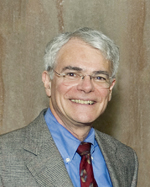From the Deputy Director for Intramural Research
Once and Future Graduate Education

This issue of the Catalyst includes an article by Meghan Mott about the history and current status of the NIH Graduate Partnerships Program (see “Grad Students Unite”). The article summarizes the birth of the program as a natural progression of NIH’s long-term interest in supporting graduate students in our laboratories and clinics and describes the outstanding situation for our graduate students in formal partnerships as well as those in individual agreements with degree-granting universities. The article and my discussions with the author evoked some happy (and not so happy) memories that I thought I would share.
For almost as long as there has been an intramural program, there have been graduate students here. You cannot keep students away from one of the most exciting, vibrant, and creative environments anywhere for conducting biomedical research. Originally, they wandered in because there was someone here with whom they wanted to work; or they followed scientists, who were constantly being recruited from academia; or they were here in another capacity and wanted to earn a doctoral degree as a reflection of the scholarly work they were already doing. The most famous personification of the last situation was Julius Axelrod, winner of the 1970 Nobel Prize in Physiology or Medicine for his work on neurotransmitters. He earned his Ph.D. from George Washington University (Washington, D.C.) based on research he was already conducting at NIH.
In the 1970s, then–Deputy Director for Intramural Research (DDIR) DeWitt “Hans” Stetten was convinced that having a degree-granting graduate school at the NIH would enrich our research community. But a survey of intramural scientists at the time revealed only lukewarm enthusiasm for this idea. About half of the senior investigators who were contacted indicated that the mission of the NIH did not include training graduate students. Instead, the Foundation for Advanced Education in the Sciences (FAES), a nonprofit that has been fostering scientific education at NIH since 1959, continued to expand its graduate-level courses and other programs.
When Harold Varmus became the NIH director in 1993, one of his goals was to establish a formal graduate program here. He enlisted me as his DDIR to move this vision forward. We felt that the presence of graduate students would ensure a more critical intellectual environment at the NIH; allow us to undertake longer-term projects suitable for graduate theses; and enable us to share the riches of this place with students who would benefit enormously from an NIH experience. We had discussions with NIH senior faculty about developing a unique curriculum for our graduate scholars, requirements for admission, faculty responsibilities, and a mechanism for central oversight of the students. When the time came for me to present our detailed proposal to the Advisory Committee to the Director (ACD) on June 3, 1999, I was excited and confident that our proposal would earn the endorsement of the ACD.
The rest is history; many of the members of the ACD—particularly those who had been at the NIH and benefited (like me and Harold Varmus) from the training here—were enthusiastic. But other prominent academics on the ACD worried about whether NIH had the know-how to take on this new responsibility; whether establishing a new graduate program was a good idea when the United States was already beginning to produce more Ph.D.s than the country could employ as independent investigators; and whether (perhaps with tongue in cheek) we might be so successful that all of the top graduate students in the country would flock here, undermining NIH-supported academic centers.
So we put our heads together, and the idea for the Graduate Partnerships Program (GPP) was conceived. We decided not to seek independent status as a degree-granting institution, but agreed to work with many partners to provide training for students who could benefit from spending time at NIH.
As the article makes clear, the GPP has been a huge success. But where do we go from here? The GPP has grown haphazardly over the past 12 years. Programs have been added without consideration of the overall balance of students. We need to think about what we would like our graduate student body to look like. Then we should ask potential partners and GPP directors to make a case for how new partnerships would advance our overall goals. Our extramural colleagues who are experienced as graduate educators can help us evaluate our programs as well as suggest how best to move forward. While for the moment we won’t initiate any new institutional agreements, new graduate students who are under individual agreements will continue to come to the NIH. As I previously noted, there is no way to keep them away—nor would we want to.
This page was last updated on Friday, April 29, 2022
